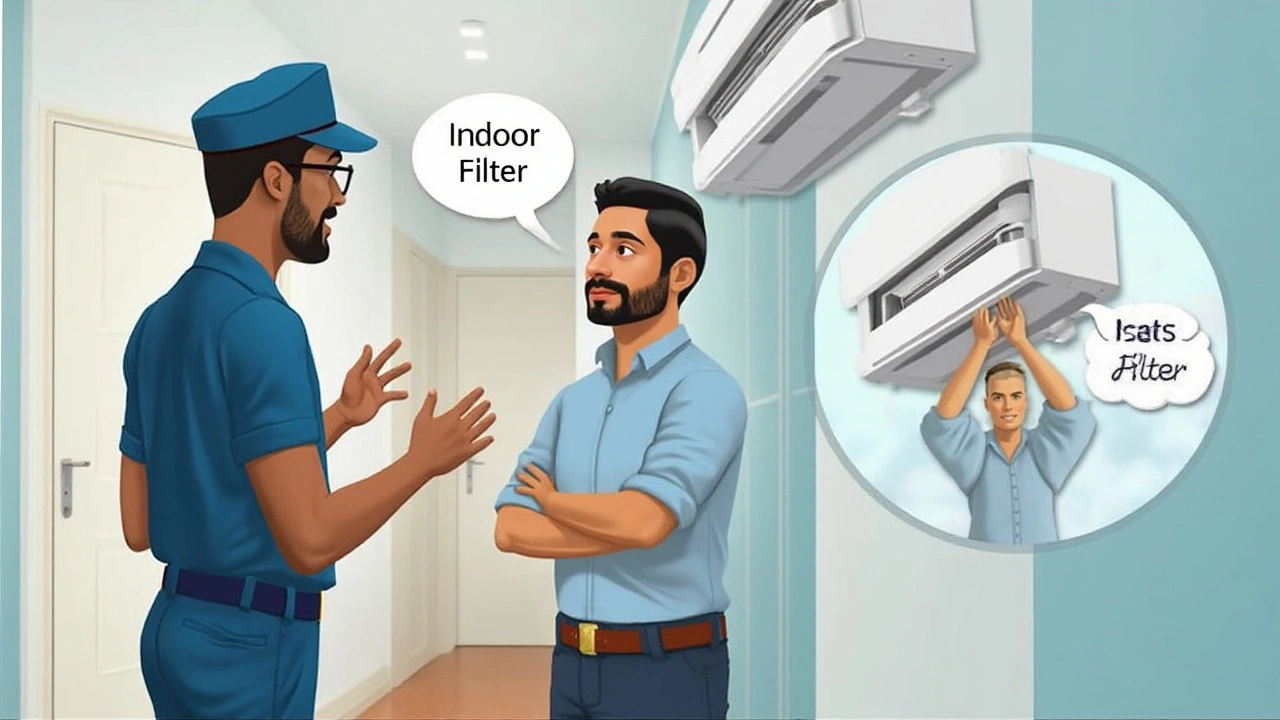If you’ve ever popped open your outside AC unit hoping to find a filter, you’re not alone. I’ve seen plenty of folks scratch their heads in the backyard, thinking there’s an air filter stashed somewhere in the big metal box buzzing away beside the house. Here’s the thing: in almost every home setup, the air filter isn’t in the outside condenser unit at all.
That outside box—the 'condenser'—handles heat and airflow, but the filter you should change lives somewhere else. Don’t waste time poking at sheet metal or risking a run-in with a wasp nest. If you’re trying to keep your AC running smooth and your air clean, we need to talk about where the filters actually hide, and why the outside unit almost never has one.
Stick with me, because we’re about to clear up this confusion. I’ll help you track down your filter’s real hiding spot and figure out exactly what you should check—no toolbox (or bug spray) required.
- Debunking the Outdoor AC Filter Myth
- Where Your AC Filter Actually Hides
- Signs Your Filter Needs Attention
- Easy Filter Maintenance Tips
Debunking the Outdoor AC Filter Myth
This comes as a surprise to a lot of people, but your outside AC unit rarely has an air filter. The part sitting in your yard—the condenser—just isn’t built for catching dust or pet hair. If you pop the panel open, you’ll see fans, coils, and maybe a few spiders, but don’t expect to yank out a dirty filter.
Why don’t outdoor condenser units have filters? Here’s the scoop: filters belong on the part of your AC where air first enters the system, which is inside your home. Your furnace or air handler does all the heavy lifting of cleaning air before it’s cooled and blown back into your rooms. The big metal box outside just moves heat—it pulls air through its fins to dump heat, but it doesn’t need to filter that air the way indoor systems do.
Actually, searching for a filter outside can cause more harm than good. Folks have accidentally bent fins, yanked wires, or just wasted a bunch of time. Some people expect every part of an HVAC system to need a regular cleaning chore, but outdoor units are mostly hands-off unless you see actual debris stuck in the coils.
- If you’re renting a place, odds are you’ll never need to open that outside unit.
- For most homes, all filter business happens inside—normally at your return air vent or inside the furnace compartment.
- Some old or commercial setups might have outdoor air intake filters, but that’s super rare in homes built after the 1980s.
Here’s a quick side-by-side look at what you’ll find in outdoor versus indoor units:
| Part | Indoor Unit | Outdoor Unit |
|---|---|---|
| Air Filter | Yes, always | Almost never |
| Dust/Hair Collected | Yes, catches debris | No, only large debris outside |
| Needs Regular Changing? | Yes (every 1-3 months) | No filter to change |
If you’re thinking, “Why is there so much confusion?” blame online searches and DIY videos. And to be fair, every now and then a commercial rooftop unit might shock you by having a filter on an outdoor air intake. But in the average home, if you’re searching for a filter outdoors, you’re on a wild goose chase.
Where Your AC Filter Actually Hides
If you’ve ever peeked inside your outside AC unit and didn’t spot a filter, you’re not missing something obvious—there just isn’t one. The filter you actually need to keep an eye on sits inside your house, not outside sweating in the sun. Most home central air systems hide the air filter in very specific spots—places you walk by every day and probably don’t even notice.
So, where should you actually look? Here are the top spots where filters are found in a standard HVAC setup:
- Inside the main HVAC unit (air handler or furnace): Pop open the door or panel near where your system pulls in air, and you’ll usually spot the filter tray.
- Behind a return vent grate: Sometimes, the filter is behind those big grates on your wall, ceiling, or hallway. These grates are usually set with clips or screws, and once opened, the filter slides right out.
- Inside a slot on the side or bottom of the furnace: This is a common spot; look for a little slot with a filter sandwiched inside, often with arrows showing the airflow direction.
If your house has more than one return vent or air handler, you might have more than one filter hiding around. Don’t just check one spot and call it a day. And, apartments or homes with thick dust or lots of pets (my cat Loki definitely counts) might need filter attention more often.
Here’s a quick breakdown of typical filter locations by system type:
| System Type | Common Filter Location |
|---|---|
| Split Central AC | Air handler/furnace compartment, return vent grille |
| Package Unit | In a side compartment of the rooftop or outdoor unit |
| Ductless Mini-Split | Behind the front panel of each indoor wall unit |
If you’re still stumped, check your owner’s manual or look for a label on the blower unit. Some older systems even have weird hidden slots that collect lint like nobody’s business. If all else fails, a sharp nose (or a nosey cat) will usually help you find the dusty culprit. Bottom line: skip the outside condenser, scout the spots indoors, and you’ll find your filter.

Signs Your Filter Needs Attention
Ever notice your house feeling stuffy or dusty, or maybe your AC is starting to sound like it’s working overtime? That’s usually your system trying to tell you it’s time to look at that air filter. Ignoring these signs can lead to higher energy bills and even damage your AC over time.
Here’s what you should watch out for:
- Weak airflow from your vents. If the air doesn’t blow as strong as it used to, a clogged filter is often the cause.
- Dust gathering on furniture not long after you’ve cleaned. A dirty filter isn’t doing its job of catching stuff that floats around indoors.
- Your AC cycle seems endless, or the unit turns on way more often. When that filter’s packed with dirt, your AC has to work harder and longer just to cool your place.
- You smell a musty or stale odor when the AC runs. Trapped dust and moisture on the filter can lead to moldy smells.
- Visible dirt or gray gunk on the filter itself. If you pull the filter and it looks like something out of a vacuum cleaner bag, it’s definitely overdue for a change.
If you have pets shedding like crazy (like Loki, my cat), expect to deal with a dirty filter even sooner. Pet hair loves to cling to those filters, making airflow worse.
Don’t wait for your AC to throw a tantrum. Checking your filter once a month—especially during hot or pollen-heavy months—can save you money and avoid headaches later. And if you have people at home with allergies, keeping your air filter fresh can make a huge difference for everyone’s breathing.
Easy Filter Maintenance Tips
If there’s one thing you can do to keep your AC happy (and your energy bill down), it’s staying on top of filter changes. Most folks change their filter every three months, but that’s a rough average. ACs in homes with pets (like my mischievous cat Loki), allergy-prone family members, or heavy dust might need a new filter every month or so.
You don’t need fancy gear for outside AC unit upkeep. Here’s a simple routine to follow for your air filter—whether it’s tucked in a hallway return vent or beside your furnace:
- Check Monthly: Hold the filter up to a light source. If you can’t see much light at all, it’s time to swap it out.
- Know Your Size: Your filter almost always has the dimensions printed on its edge—write these down or snap a photo. Getting the wrong size means it won’t catch much of anything.
- Install Properly: There’s usually an arrow on the filter showing airflow direction. Make sure it matches the way air actually travels in your system (toward the blower fan).
- Set a Reminder: Seriously, your phone can save your lungs and your wallet here. Set a calendar reminder, because forgetting is just too easy.
- Buy in Bulk: Filters are way cheaper by the pack—plus, you’re less tempted to put off the swap.
Let’s put some quick numbers to why maintenance matters. A clogged filter can knock 5-15% off your system’s efficiency, making your AC work harder and jacking up that power bill.
| Frequency of AC Use | Recommended Filter Change |
|---|---|
| Everyday (pets, allergies) | Monthly |
| Normal household | Every 2-3 months |
| Vacation home / infrequent use | Every 6 months |
If you grab a cheap fiberglass filter, change it frequently—these get dirty fast. Pleated or HEPA-style filters last longer and catch smaller stuff. Just be sure your system is rated for the thicker options or you could cut down airflow too much.
Don’t forget: when the filter looks fuzzy or you see a weird musty smell when the AC kicks on, switch it out. Your system and your sinuses will thank you. And if your filter ever looks chewed up or covered in pet hair—yep, I’m looking at you, Loki—it’s definitely time.




